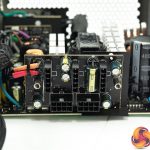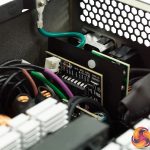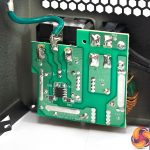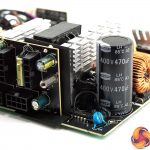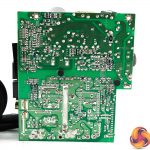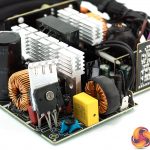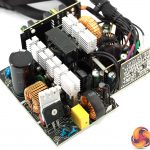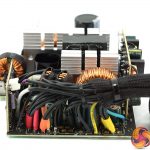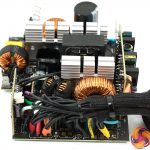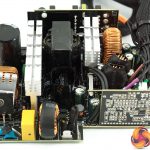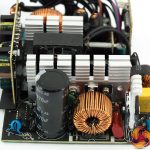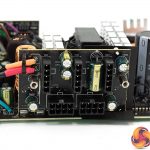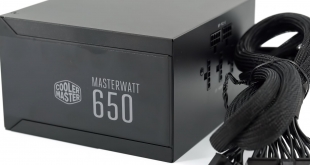
Today we take a look at a 650 watt power supply from a new range of Bronze rated units from Cooler Master. The Masterwatt range are semi modular, semi fanless, 80 Plus Bronze certified and targeted at the lower end of the market with prices ranging between £55 and £75.
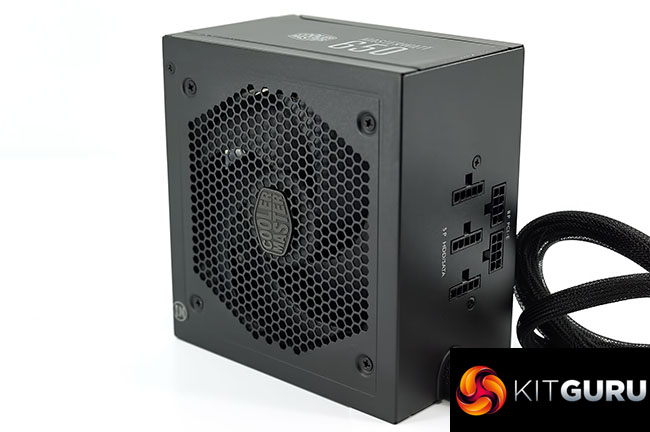
Cooler Master are not hiding the fact that this MasterWatt series is targeting the budget audience. In a time where 80 Plus Gold certification seems almost standard – releasing a Bronze rated unit in 2017 seems rather uninspiring. We know Cooler Master have released some wonderful power supplies in the past, for instance – the limited edition, mega costly MasterWatt Maker 1200W MIJ has to rate as one of the finest units we have ever tested (review HERE). It would be fair to say that this MasterWatt range of power supplies are right at the opposite end of the spectrum.
Cooler Master offer a 5 year warranty with these units – which is pretty much in line with many of the 80 Plus Bronze certified units available today but far short of the 10-12 year warranty offered by companies such as Seasonic in the higher end marketplace.
Cooler Master MasterWatt Specifications:
- Noiseless operation up to 15% load.
- 80 Plus Bronze Certified.
- Silencio FP 120 with LDB bearing.
- More Conductive PCI-e cables.
- DC to DC Circuit Design.
- 5 Year warranty.
Review photography handled in house at KitGuru with a Leica S series medium format camera and S series prime lens. Please do not use any of the images within this review without express permission.
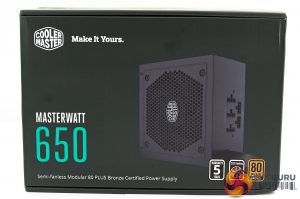
The Cooler Master MasterWatt 650 arrives in a dark box which is rather understated. There is an image of the unit bottom right, with some details such as the 80 Plus Bronze rated certification and 5 year warranty.
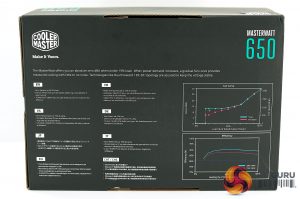
The back of the power supply box focuses on the zero dBa feature with the unit is under a 15% load. In the case of the 650 Watt unit we are reviewing today that would mean the load has to be less than 97.5 watts before the zero fan feature would implement.
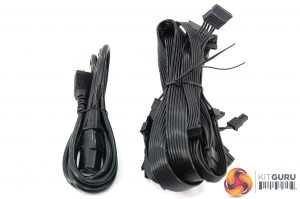
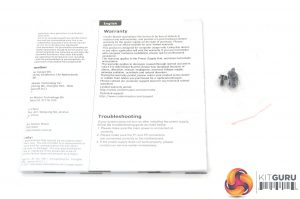
Inside we have a regional specific power cable (in our case it wasn't a UK one for some reason), a bundle of ribbon style modular cables, product literature and mounting screws. It is a pretty spartan bundle, as we would expect at the price point.
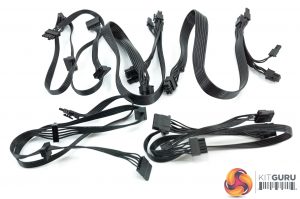
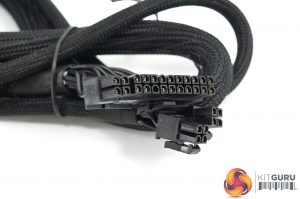
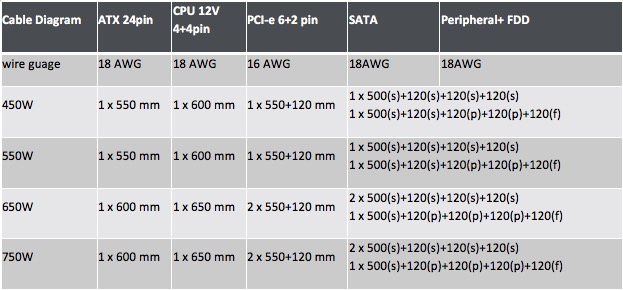
The MasterWatt 650 is not a pure modular design so there are some hard wired cables coming out of the chassis itself (picture above right). All of the modular cables are high quality with Cooler Master opting for 16 AWG cables for the PCI-e cables.
The diagram above shows that the 650 watt unit ships with 2 PCI-e 6+2 pin cables which are 550 mm + 120 mm long. This is identical to the higher output 750 watt model.
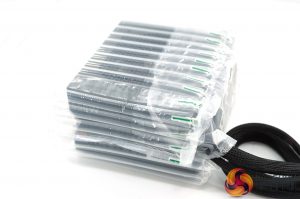
There is not much protection inside the package – its basically a simple cardboard box for shipping. Cooler Master however are using a thick padded bubble wrap packet around the power supply which looks to offer decent protection during shipping.
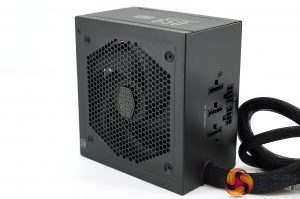
The Cooler Master MasterWatt 650 is a fairly basic looking power supply – predominately black which makes it compatible for a wide variety of system builds. No clashes of colours to cause issues.
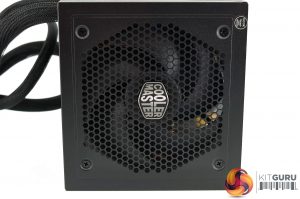
A large fan takes centerstage behind the metal grill with Cooler Master branding in the middle. We will take a closer look at this fan when we open the unit up later in the review.
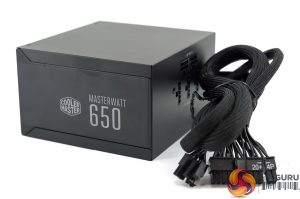
One panel has the Cooler Master logo and model name/size in shown in gray. Again keeping the mono aesthetic. The paint work is actually reasonably good quality throughout although it does attract fingerprints.
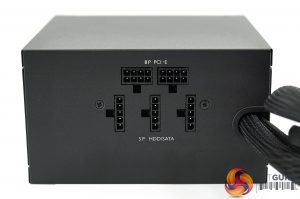
One side of the unit is home to the modular connector bay – its pretty simple, labelled and due to the cable size differences impossible to get wrong.
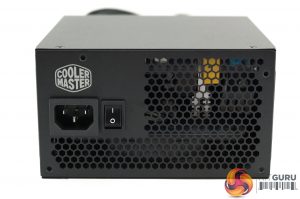
The other side of the power supply is home to the power switch, connector and vented panel. Another Cooler Master badge is positioned above the power connector.
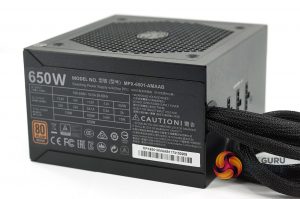
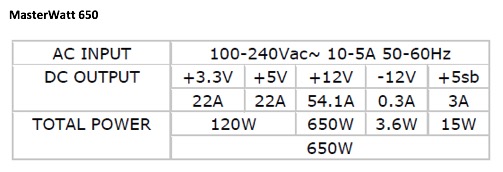
This unit is capable of 22A via the +3.3V and +5V rail. The single +12V rail can handle 54A, plenty of juice for a high powered graphics card.
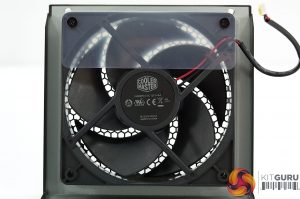
Cooler Master are using a fan made in China which shows a rating of up to 2,500 rpm 12v 0.16A. Looking closer into the fan design we can see its an LDB (Loop Dynamic Bearing) bearing design with model number DF1202512RFLN. Life expectancy for this particular fan is said to be around the 160,000 hour mark. It is self lubricating and dust sealed.
Below is a gallery of the internal power supply design. If they do not display then whitelist our site in your adblocker as they can interfere with our display code.
We can see that HEC is Cooler Master OEM of choice for this design and the overall design is clean and soldering quality is decent for the price point. It is a APFC+ Double Forward design with Synchronous Rectification and DC-DC converters on the secondary side.
The primary capacitor is by Chinese brand TEAPO and is rated at 85c (400V 470uF) – not 105c. I am not a big fan of TEAPO capacitors as I have had several fail (one quite horribly) in previous years. I have been told they have improved their manufacturing process in recent years but I still have doubts about long term reliability – so I was immediately disappointed to see them used throughout this design.
Obviously Cooler Master are aiming for a low price point but I do feel at times skimping in key areas like this can greatly impact overall reliability. TEAPO caps are even visible on the vertically mounted modular bay PCB. Its doubly disappointing as Cooler Master have stated that the two key factors in mind when designing this power supply were low noise and reliability.
Transient Filtering comprises 5x Y Caps, 2 x X Caps, 2x EMI Choke and 1 MOV. APFC MOSFETS are 2x Great Power GP18S50XN220FP (500V, 18A). The Combo APFC, PWM Controller is a Champion CM6800TX. The Bridge Rectifier are 2x MCC, GBU10K (800V, 10A@150c).
Correctly testing power supplies is a complex procedure and KitGuru have configured a test bench which can deliver up to a 2,000 watt DC load. We run at 35c in our environment to greater reflect warmer internal chassis conditions.
We use combinations of the following hardware:
• SunMoon SM-268
• CSI3710A Programmable DC load (+3.3V and +5V outputs)
• CSI3711A Programmable DC load (+12V1, +12V2, +12V3, and +12V4)
• Extech Power Analyzer
• Extech MultiMaster MM570 digital multimeter
• Extech digital sound level meter
• Digital oscilloscope (20M S/s with 12 Bit ADC)
• Variable Autotransformer, 1.4 KVA
We test in a single +12V configuration.
|
DC Output Load Regulation
|
||||||||||
|
Combined DC Load |
+3.3V
|
+5V
|
+12V
|
+5VSB
|
-12V | |||||
|
A
|
V
|
A
|
V
|
A
|
V
|
A
|
V
|
A | V | |
|
65W
|
0.92
|
3.33
|
0.88
|
5.04
|
4.42
|
12.16 |
0.50
|
5.02
|
0.20
|
-12.03
|
|
130W
|
1.63
|
3.32
|
1.65
|
5.02
|
9.18
|
12.11
|
0.50
|
5.02
|
0.20
|
-12.03
|
|
325W
|
2.93
|
3.31
|
3.00
|
5.00
|
24.25
|
12.07 |
1.50
|
5.00
|
0.20
|
-12.03
|
| 490W |
4.04
|
3.30
|
4.10
|
4.98
|
36.90
|
12.00
|
2.00
|
4.97 |
0.30
|
-12.02
|
|
650W
|
5.00
|
3.28
|
5.30
|
4.95
|
49.67
|
11.94
|
2.50
|
4.95
|
0.30
|
-12.01
|
Load regulation is pretty good, within 2.5%.
| Cooler Master MasterWatt 650 | Maximum Load |
| 684 watts |
We managed to get the PSU to deliver 684 watts before it would shut down, delivering around 34 watts more than the rated specifications.
Next we want to try Cross Loading. This basically means loads which are not balanced. If a PC for instance needs 500W on the +12V outputs but something like 30W via the combined 3.3V and +5V outputs then the voltage regulation can fluctuate badly.
| Cross Load Testing | +3.3V | +5V | +12V | -12V | +5VSB | |||||
| A | V | A | V | A | V | A | V | A | V | |
| 590W | 1.0 | 3.33 | 1.0 | 5.04 | 48.0 | 11.92 | 0.2 | -12.00 | 0.50 | 5.01 |
| 145W | 12.0 | 3.25 | 15.0 | 4.89 | 2.0 | 12.15 | 0.2 | -12.01 | 0.50 | 4.98 |
The unit passed our cross load test. It was hit with 48A on the +12V rail and it held at 11.92.
We then used an oscilloscope to measure AC ripple and noise present on the DC outputs. We set the oscilloscope time base to check for AC ripple at both high and low ends of the spectrum. ATX12V V2.2 specification for DC output ripple and noise is defined in the ATX 12V power supply design guide.
|
ATX12V Ver 2.2 Noise/Ripple Tolerance
|
|
|
Output
|
Ripple (mV p-p)
|
|
+3.3V
|
50
|
|
+5V
|
50
|
|
+12V1
|
120
|
|
+12V2
|
120
|
|
-12V
|
120
|
|
+5VSB
|
50
|
Obviously when measuring AC noise and ripple on the DC outputs the cleaner (less recorded) means we have a better end result. We measured this AC signal amplitude to see how closely the unit complied with the ATX standard.
| AC Ripple (mV p-p) | ||||
| DC Load | +3.3V | +5V | +12V | 5VSB |
| 152W | 5 | 10 | 10 | 5 |
| 270W | 10 | 10 | 20 | 5 |
| 400W | 10 | 15 | 30 | 10 |
| 523W | 15 | 20 | 40 | 15 |
| 650W | 15 | 20 | 50 | 15 |
Ripple suppression is quite good, hitting 15mV and 20mV on the +3.3V and +5V rails respectively at full load. The +12V rail hit 50mV at full load, well within industry rated specifications.
|
Efficiency (%)
|
|
|
152W
|
86.3
|
|
270W
|
89.2
|
|
400W
|
88.7
|
|
523W
|
87.4
|
|
650W
|
86.6
|
Efficiency is pretty good for a 80 Plus Bronze unit, peaking at just over 89% and dropping to 86.6% at full load.
We take the issue of noise very seriously at KitGuru and this is why we have built a special home brew system as a reference point when we test noise levels of various components. Why do this? Well this means we can eliminate secondary noise pollution in the test room and concentrate on components we are testing. It also brings us slightly closer to industry standards, such as DIN 45635.
Today to test the Power Supply we have taken it into our acoustics room environment and have set our SkyTronic DSL 2 Digital Sound Level Meter (6-130dBa) one meter away from the unit. We have no other fans running so we can effectively measure just the noise from the unit itself.
As this can be a little confusing for people, here are various dBa ratings in with real world situations to help describe the various levels.
KitGuru noise guide
10dBA – Normal Breathing/Rustling Leaves
20-25dBA – Whisper
30dBA – High Quality Computer fan
40dBA – A Bubbling Brook, or a Refrigerator
50dBA – Normal Conversation
60dBA – Laughter
70dBA – Vacuum Cleaner or Hairdryer
80dBA – City Traffic or a Garbage Disposal
90dBA – Motorcycle or Lawnmower
100dBA – MP3 Player at maximum output
110dBA – Orchestra
120dBA – Front row rock concert/Jet Engine
130dBA – Threshold of Pain
140dBA – Military Jet takeoff/Gunshot (close range)
160dBA – Instant Perforation of eardrum
|
Noise (dBA)
|
|
|
152W
|
<28.0
|
|
270W
|
<28.0
|
|
400W
|
31.5
|
|
523W
|
33.2
|
| 650W | 34.9 |
Audio emissions are actually very impressive – with the power supply not really emitting noticeable noise until around 500 watts is demanded.
|
Temperature (c)
|
||
|
Intake
|
Exhaust
|
|
|
152W
|
36
|
41
|
|
270W
|
39
|
44
|
|
400W
|
42
|
49
|
|
523W
|
44
|
53
|
|
650W
|
47
|
62
|
At full load we measured temperatures around 62c.
|
Maximum load
|
Efficiency
|
|
684 watts
|
86
|
At 684 watts, the efficiency level measures 86%. Not a practical situation to be running 24/7, but worth noting.
It is clear the Cooler Master MasterWatt 650 Power Supply is designed to target the budget enthusiast audience. WIth a price point at only £64.99 inc vat it will definitely be a healthy option for a specific audience with limited funds.
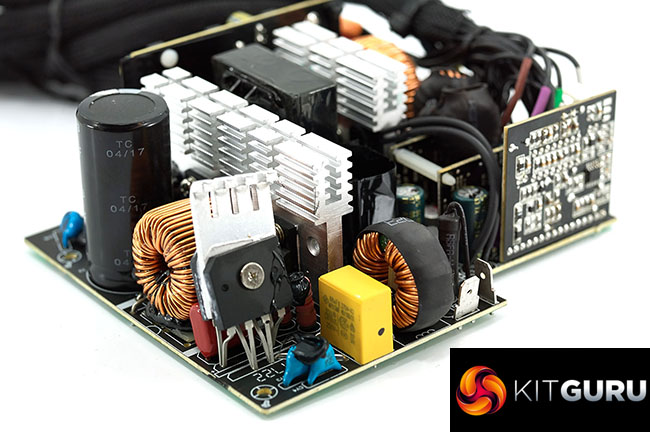
The packaging and bundle is rather spartan with only the power supply protected – wrapped inside clear plastic bubble wrap. It should be adequate protection but I have concerns if the box took a hard hit during shipping.
The power supply itself is nicely finished and the paint work is fairly resistant to scratches. The plain black finish will appeal to the enthusiast audience building a colour coordinated system on a budget. The cabling quality is also rather nice, with Cooler Master adopting 16 AWG cables to reduce resistance.
Internally, the HEC design has proved solid overall. My only point of contention is the adoption of cheap Chinese 85c rated capacitors throughout. While the quality of these has been said to have improved in recent years, I have experienced some pretty nasty failures in other units which gives me concerns about long term reliability. Ironic considering Cooler Master say they are focusing on two key selling points for these units – reliability and low noise.
While it is impossible for me to test 2-3 year long reliability for a launch within only a few weeks I can say that Cooler Master have succeeded with their claims of low noise. The large LDB fan they have adopted is whisper quiet, only making its presence known within the last 200 watts of power delivery.
So is this power supply a success story for Cooler Master? Technically it passed our tests with pretty good results overall, however there are always concerns when we see 85c rated TEAPO capacitors in any enthusiast grade power supply. I also think an 80 Plus Bronze rating seems horribly outdated in 2017. For me, Gold is the new Bronze and it has been for some time.
If you are on a strict budget and have only £65 to spare, then the Cooler Master MasterWatt 650 makes for a decent enough purchase. I just have concerns about long term reliability due to the adoption of budget oriented Chinese TEAPO capacitors throughout the design. For an extra £20 you could get an 80 Plus Gold unit with Japanese capacitors inside. And that's the true foundation for a reliable power supply.
For more information check out this page on SCAN.
Pros:
- quality cabling.
- technically quite solid.
- quiet.
Cons:
- Cheap 85c Chinese capacitors used throughout.
- 80 Plus gold units with Japanese capacitors actually don't cost a lot more.
Kitguru says: The Cooler Master MasterWatt 650 is a decent performing unit at a competitive price point.
 KitGuru KitGuru.net – Tech News | Hardware News | Hardware Reviews | IOS | Mobile | Gaming | Graphics Cards
KitGuru KitGuru.net – Tech News | Hardware News | Hardware Reviews | IOS | Mobile | Gaming | Graphics Cards


